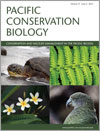
Pacific Conservation Biology
Volume 21 Number 2 2015
PC14912Conservation, mismatch and the research–implementation gap
This paper reports on the outcomes from a workshop at the Society for Conservation Biology Oceania Conference 2014 on bridging the research–implementation gap. Workshop participants identified five mismatches between conservation research and practice, and recommended seven ways we can work together to bridge the gap.
PC14912 Abstract | PC14912 Full Text | PC14912PDF (79 KB) Open Access Article
PC14916The UK Government agrees to create the world's largest marine reserve around the Pitcairn Islands, a UK Overseas Territory in the South Pacific
In March 2015, the UK Government announced their intention to create the World’s largest marine reserve in the territorial waters of the Pitcairn Islands in the Pacific Ocean. This achievement followed a concerted effort by a consortium of scientists, environmental campaigners and Members of Parliament, who engaged cooperatively in the building of the scientific evidence base and advocacy campaigns.
PC14908Mapping seagrass cost-effectively in the Coral Triangle: Sabah, Malaysia as a case study
The purpose of this paper was to use alternative cost-effective methods of mapping seagrass in addition to traditional scientific methods in the Coral Triangle. Interview surveys, spot sampling and manta tows were the semi quantitative, complementary methods used to provide the necessary information for refining scientific transect surveys for mapping seagrasses in Sabah, Malaysia.
PC14909Multiple paternity in captive grey nurse sharks (Carcharias taurus): implications for the captive breeding of this critically endangered species
Grey nurse sharks (Carcharias taurus) are endangered throughout most of their range and captive breeding programs have thus far been largely unsuccessful. Here we investigate for the first time the species’ mating system in captivity and discuss implications for the captive breeding of this endangered and iconic shark.
PC14910Impact of grazing on fine fuels and potential wildfire behaviour in a non-native tropical grassland
Non-native grasses invade ecosystems globally, increasing fuel loads and the frequency and intensity of wildfires. This situation is particularly true in the tropics where Megathyrsus maximus (guinea grass) has invaded. We tested the use of domestic livestock grazing to reduce fuels and wildfire behaviour in Hawai‘i. Our results demonstrate that cattle grazing can be an effective approach for wildfire management in non-native-dominated tropical grasslands.
PC14911Characteristics of nest trees and nest hollows used by the forest red-tailed black cockatoo (Calyptorhynchus banksii naso) in south-west Western Australia: comments on Johnstone et al. (2013)
This paper contributes to the discussion of threats to the supply of breeding hollows and trees used by forest red-tailed black cockatoo in south-west Western Australia (Johnstone et al. 2013) (Pacific Conservation Biology 19, 122–141) by presenting data and providing information on the spatial and management background
PC14913The effect of changing land use on the availability of potential nest trees for the endangered Muir's corella (Cacatua pastinator pastinator): a case study of the establishment of commercial Tasmanian blue gum plantations in Western Australia
Diversifying farm incomes with eucalyptus plantations is common in Australia. Most early plantations were established in cleared paddocks following the removal of isolated stands of trees or single trees. The potential impact of this tree removal on nest hollow availability has been ignored up until now. Governments need to reassess the impact of the loss of this critical habitat to Australian biodiversity.
PC14914Insights into the attributes of Pacific Island destinations that appeal to avitourists
Avitourism can provide alternative revenue raising opportunities and may enhance conservation outcomes. The most memorable and most desired Pacific Island destinations were explored using an online survey. New Zealand was the most memorable destination and the most desired was Papua New Guinea. Unique and endemic species are key attractions for avitourists visiting Pacific Islands.
PC14915Non-target species interaction with sodium fluoroacetate (1080) meat bait for controlling feral pigs (Sus scrofa)
Monitoring of poison meat baits used for controlling feral pigs show they are visited and sampled by some native species. Trial results suggest that dying bait green may help reduce native species interactions, and any potential poisoning risk. Further testing is recommended, particularly to ensure that dyed baits remain attractive to feral pigs.
PC14917Satellite tracking of rehabilitated wild Baudin’s cockatoos, Calyptorhynchus baudinii: a feasibility trial to track forest black cockatoos
This study demonstrated successful satellite tracking of Baudin’s cockatoo, Calyptorhynchus baudinii, a threatened forest black cockatoo species, endemic to the south-west of Western Australia. Tail-mounted satellite transmitters were attached to two rehabilitated wild Baudin’s cockatoos and the birds tracked for up to five months post-release.



